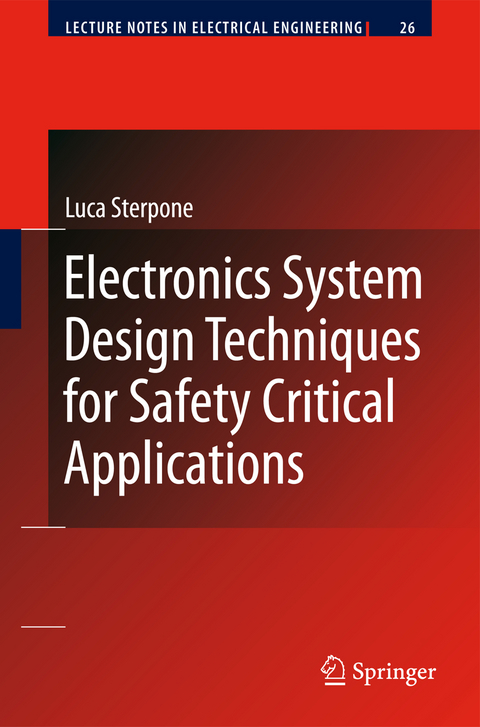
Electronics System Design Techniques for Safety Critical Applications
Seiten
2010
|
Softcover reprint of hardcover 1st ed. 2009
Springer (Verlag)
978-90-481-8041-7 (ISBN)
Springer (Verlag)
978-90-481-8041-7 (ISBN)
A safety system should be defined as a system that will not endanger human life or the environment. State of the art electronic systems are increasingly adopting progr- mable devices for electronic applications on earthling system.
What is exactly “Safety”? A safety system should be defined as a system that will not endanger human life or the environment. A safety-critical system requires utmost care in their specification and design in order to avoid possible errors in their implementation that should result in unexpected system’s behavior during his operating “life”. An inappropriate method could lead to loss of life, and will almost certainly result in financial penalties in the long run, whether because of loss of business or because the imposition of fines. Risks of this kind are usually managed with the methods and tools of the “safety engineering”. A life-critical system is designed to 9 lose less than one life per billion (10 ). Nowadays, computers are used at least an order of magnitude more in safety-critical applications compared to two decades ago. Increasingly electronic devices are being used in applications where their correct operation is vital to ensure the safety of the human life and the environment. These application ranging from the anti-lock braking systems (ABS) in automobiles, to the fly-by-wire aircrafts, to biomedical supports to the human care. Therefore, it is vital that electronic designers be aware of the safety implications of the systems they develop. State of the art electronic systems are increasingly adopting progr- mable devices for electronic applications on earthling system. In particular, the Field Programmable Gate Array (FPGA) devices are becoming very interesting due to their characteristics in terms of performance, dimensions and cost.
What is exactly “Safety”? A safety system should be defined as a system that will not endanger human life or the environment. A safety-critical system requires utmost care in their specification and design in order to avoid possible errors in their implementation that should result in unexpected system’s behavior during his operating “life”. An inappropriate method could lead to loss of life, and will almost certainly result in financial penalties in the long run, whether because of loss of business or because the imposition of fines. Risks of this kind are usually managed with the methods and tools of the “safety engineering”. A life-critical system is designed to 9 lose less than one life per billion (10 ). Nowadays, computers are used at least an order of magnitude more in safety-critical applications compared to two decades ago. Increasingly electronic devices are being used in applications where their correct operation is vital to ensure the safety of the human life and the environment. These application ranging from the anti-lock braking systems (ABS) in automobiles, to the fly-by-wire aircrafts, to biomedical supports to the human care. Therefore, it is vital that electronic designers be aware of the safety implications of the systems they develop. State of the art electronic systems are increasingly adopting progr- mable devices for electronic applications on earthling system. In particular, the Field Programmable Gate Array (FPGA) devices are becoming very interesting due to their characteristics in terms of performance, dimensions and cost.
Winner of the EDAA (European Design Automation Association) Outstanding Monograph Award in the Reconfigurable Electronics section
An Introduction to FPGA Devices in Radiation Environments.- Radiation Effects on SRAM-Based FPGAs.- Analytical Algorithms for Faulty Effects Analysis.- Reliability-Oriented Place and Route Algorithm.- A Novel Design Flow for Fault Tolerance SRAM-Based FPGA Systems.- Configuration System Based on Internal FPGA Decompression.- Reconfigurable Devices for the Analysis of DNA Microarray.- Reconfigurable Compute Fabric Architectures.
| Erscheint lt. Verlag | 23.11.2010 |
|---|---|
| Reihe/Serie | Lecture Notes in Electrical Engineering ; 26 |
| Zusatzinfo | XVI, 146 p. |
| Verlagsort | Dordrecht |
| Sprache | englisch |
| Maße | 155 x 235 mm |
| Themenwelt | Mathematik / Informatik ► Informatik ► Netzwerke |
| Informatik ► Theorie / Studium ► Künstliche Intelligenz / Robotik | |
| Technik ► Elektrotechnik / Energietechnik | |
| ISBN-10 | 90-481-8041-4 / 9048180414 |
| ISBN-13 | 978-90-481-8041-7 / 9789048180417 |
| Zustand | Neuware |
| Haben Sie eine Frage zum Produkt? |
Mehr entdecken
aus dem Bereich
aus dem Bereich
was sie kann & was uns erwartet
Buch | Softcover (2023)
C.H.Beck (Verlag)
18,00 €
von absurd bis tödlich: Die Tücken der künstlichen Intelligenz
Buch | Softcover (2023)
Heyne (Verlag)
20,00 €


